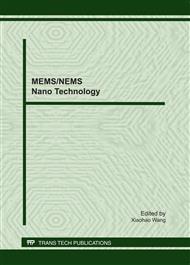p.276
p.281
p.287
p.293
p.297
p.301
p.305
p.311
p.316
A Porous Microfluidic Chip for Protein Extraction Based on Solid Phase Extraction Method
Abstract:
Based on the principle of solid phase extraction (SPE) and the special immunoreaction, a microfluidic chip integrated with porous matrix was developed for protein extraction. Porous matrix was achieved by electrochemical etching silicon in a HF/ethanol mixture, which was coated on the wall of the rectangular channel of the microchip to provide a surface-enlarging matrix. The surface morphology of the bare porous silicon and the porous silicon modified with the protein has been characterized by SEM. Non-porous chip and porous chip were used to extract protein. Compared with non-porous matrix, the porous matrix achieved higher extracted efficiency of protein. Then two methods of surface modification were employed on porous matrix for protein extraction. The surface modification with Protein A could extract more protein with less non-special absorption. Evaluation of the structure of the solid phase matrix and the surface modification process in the microfluidic chip, the porous microfluidic chip is able to be suitable for incorporation into micro total analysis system (μTAS).
Info:
Periodical:
Pages:
297-300
Citation:
Online since:
June 2011
Authors:
Price:
Сopyright:
© 2011 Trans Tech Publications Ltd. All Rights Reserved
Share:
Citation:


